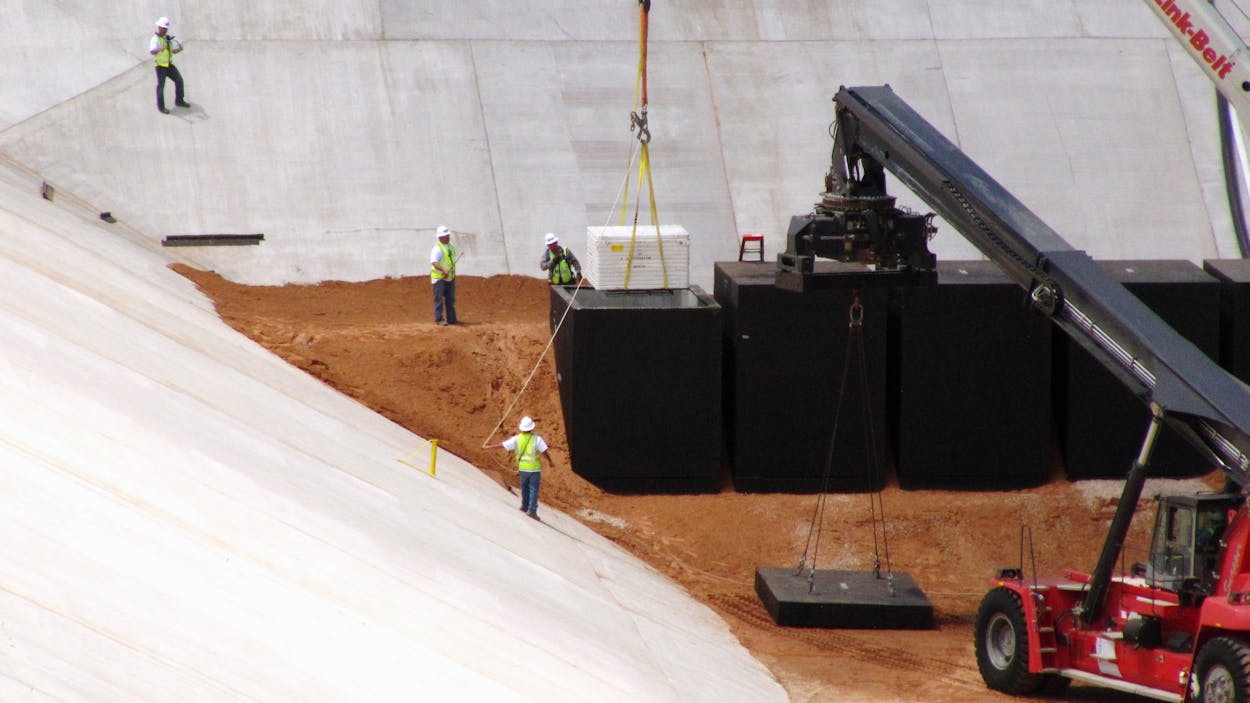In January, the U.S. Nuclear Regulatory Commission accepted an application for review from Dallas-based Waste Control Specialists that would allow high-level nuclear waste to be stored at the company’s existing low-level nuclear waste site on the outskirts of Andrews, Texas. At the time, it looked as though the wheels were in motion for high-level nuclear waste to arrive at the West Texas facility as soon as 2021, even though the project seemed to split area residents. Some feared a detrimental environmental impact, but others saw the project as a potential economic boom.
A judge’s recent decision might derail the project completely. U.S. District Judge Sue L. Robinson of Delaware blocked a $367 million merger between Waste Control Specialist and Salt Lake City-based EnergySolutions on Wednesday. The Dallas company said that the merger was necessary for the company’s longterm future, according to the Texas Tribune.
“Substantial evidence showed that head-to-head competition between EnergySolutions and Waste Control Specialists led to better disposal services at lower prices,” Acting Assistant Attorney General Andrew Finch of the Justice Department’s Antitrust Division said in a statement on Wednesday. “Today’s decision protects competition in an industry that is incredibly difficult to enter.”
When Waste Control Specialists announced its sale to EnergySolutions last year, the deal was promptly challenged by the U.S. Department of Justice, which alleged the merger would violate antitrust regulations. The companies, however, claimed that it was necessary for Waste Control Specialists’ survival. Van H. Beckwith, a lawyer for Waste Control Specialists, told Bloomberg BNA in April that the company suffered $30 million in losses last year and is projected to lose at least $250 million more over the next five years. “We are a failing firm,” Beckwith told BNA. “We are a classic one.”
The trial, which began in late April, was the first for DOJ’s antitrust division under President Donald Trump. Energy Secretary Rick Perry publicly supported Waste Control Specialists’s plan to bring high-level nuclear waste to Andrews while he was governor of Texas. One of Perry’s top political donors was Harold Simmons, who controlled Waste Control Specialists under an umbrella company. According to the Austin American-Statesman, Simmons gave at least $1.4 million to Perry from 2003 until his death in 2013 (a spokesman for Perry told the Statesman in January that Perry has no ties to Waste Control Specialists, and in February a spokesperson for the company denied any suggestion of “crony capitalism” to Energywire).
The judge’s decision doesn’t bode well for the future of Waste Control Specialists’ proposed high-level waste site. Waste Control Specialists asked the NRC in April to temporarily suspend the review of its application, citing “enormous financial challenges,” according to a letter the company sent the regulatory agency. Waste Control Specialists wrote that it “is faced with a magnitude of financial burdens that currently make pursuit of licensing unsupportable,” not least of which was being involved in a costly lawsuit.
But apparently Waste Control Specialists also didn’t expect the application process to be so costly. “The NRC recently provided WCS an estimate of the cost of the application review of $7.5 million, which is significantly higher than we originally estimated,” the letter states. “Also, the costs associated with the commencement of the public participation process and a potential adjudicatory hearing before the Atomic Safety and Licensing Board, are estimated to be considerable, especially in the very near term. The cost sharing arrangement WCS had in place with one of its partners for this project has been depleted, and WCS has been unable to reach an agreement to extend these arrangements. At the same time, WCS has faced significant operating losses in each of its operating years, and the cost of actively pursuing the project only serves to increase those losses.” According to the Texas Tribune, the NRC agreed to pause the application review process.
The company has long been planning for this project, but the fact that it has run into financial problems shouldn’t necessarily come as a surprise. According to the Texas Observer, in a thirty-page legislative report draft completed way back in 2012, staff members of the Texas Commission on Environmental Quality expressed concerns about the company’s ability to cover potential liabilities and decommissioning costs (most of those concerns were removed from the report before it was finalized). More recently, argued in federal court that it is “failing.”
As the Texas Observer noted, the Department of Energy would likely have a direct impact on the kind of high-level nuclear waste Waste Control Specialists wants to bring to Andrews, since the agency oversees the dismantling of the nation’s nuclear arsenal and assists in the disposal of nuclear waste produced by power plants and the military. The NRC defines high-level nuclear waste as “highly radioactive and potentially harmful.” The stuff is basically spent reactor fuel, and it can only become harmless through decay, which, according to the NRC, can take hundreds of thousands of years.
According to NPR, the facility would have the capacity to take up to 80 percent of the waste currently being stored at shut-down reactors across the country, meaning high-level nuclear waste from as far away as Oregon and New York could be transported by rail through more densely populated parts of Texas. That’s raised safety concerns in places that may fall along the route. Fearing what is perceived as an unnecessary risk, the San Antonio City Council and Midland and Bexar County Commissioners have already passed resolutions expressing their opposition to allowing the transportation of high-level waste through their communities. More municipalities could follow.
But with Waste Control Specialists clearly struggling, it seems high-level nuclear waste is still a long ways away from coming to West Texas.
- More About:
- Energy






